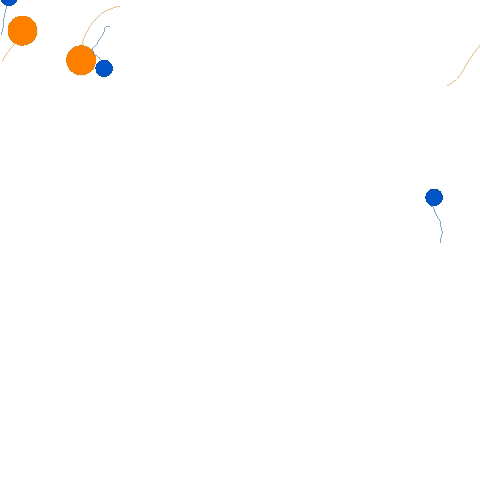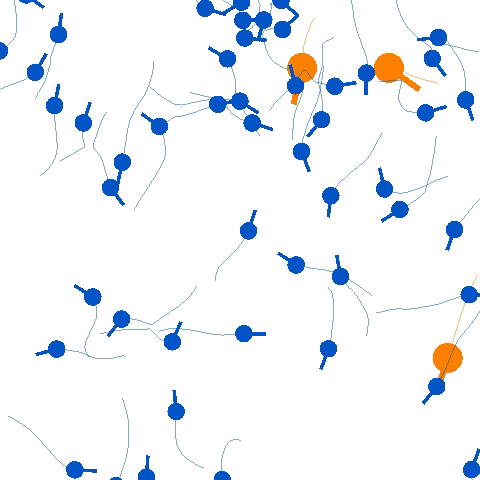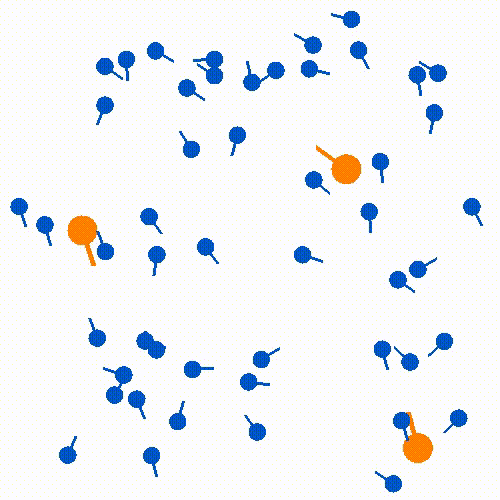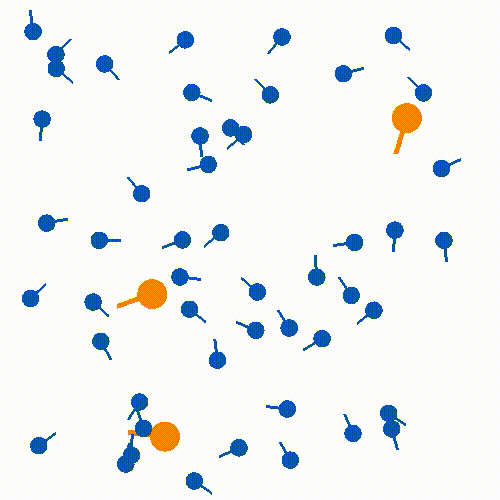Gym-PPS is a lightweight Predator-Prey Swarm environment seamlessly integrated into the standard Gym library. Its purpose is to provide a convenient platform for rapidly testing reinforcement learning algorithms and control algorithms utilized in guidance, swarming, or formation tasks. The Bilibili video has reached a milestone of 
Please note that the current version of Gym-PPS supports Python 3.8. Therefore, it is recommended to run the library within a Python 3.8 environment, which can be easily set up using a virtual environment such as venv.
We have plans to publish the project on PyPI in the near future. However, at this stage, the library needs to be manually installed.
python setup.py installTo quick start, run the following test example:
cd example_pps
python test_pps.pyA simulation window will pop up as follows:
 |
 |
| Cartesian Mode | Polar Mode |
Using Gym-PPS is quite simple:
## Define the Predator-Prey Swarm (PPS) environment
scenario_name = 'PredatorPreySwarm-v0'
# customize PPS environment parameters in the .json file
custom_param = 'custom_param.json'
## Make the environment
env = gym.make(scenario_name)
custom_param = os.path.dirname(os.path.realpath(__file__)) + '/' + custom_param
env = PredatorPreySwarmCustomizer(env, custom_param)
## If NEEDED, Use the following wrappers to customize observations and reward functions
# env = MyReward(MyObs(env))
n_p = env.get_param('n_p')
n_e = env.n_e
s = env.reset() # (obs_dim, n_peo)
for step in range(100):
env.render( mode='human' )
a_pred = np.random.uniform(-1,1,(2, n_p))
a_prey = np.random.uniform(-1,1,(2, n_e))
a = np.concatenate((a_pred, a_prey), axis=-1)
s_, r, done, info = env.step(a)
s = s_.copy()To customize the parameters of the environment, such as the number of predators and the dynamics mode, you can easily specify the desired values in the custom_param.json file, as shown below:
{
"dynamics_mode": "Polar",
"n_p": 3,
"n_e": 10,
"pursuer_strategy": "random",
"escaper_strategy": "nearest",
"is_periodic": true
}You can also directly set or get the environment parameters:
n_p = env.get_param('n_p')
env.set_param('n_p', 10)To customize your own observation or reward functions, modify the functions in custom_env.py:
class MyObs(gym.ObservationWrapper):
def __init__(self, env):
super().__init__(env)
self.observation_space = spaces.Box(shape=(2, env.n_p+env.n_e), low=-np.inf, high=np.inf)
def observation(self, obs):
r"""Example::
n_pe = self.env.n_p + self.env.n_e
obs = np.ones((2, n_pe))
return obs
"""
return obs
class MyReward(gym.RewardWrapper):
def reward(self, reward):
r"""Example::
reward = np.sum(self.env.is_collide_b2b)
"""
return rewardThen you should add the following wrappers in your file which creates environment to customize observations and reward functions
env = MyReward(MyObs(env)) To train your own network, run main.py in NJP_algorithm folder. You can also customize your enviroment using the methods provided.
Then your models will be loaded in models folder. To visualize your models effect, run testmodel.py in NJP_algorithm folder.
A trained model will be presented as follows:
 |
 |
| After Evolution | Confuse Effect |
Below is a list of the parameters that can be customized:
| Parameter name | Meaning | Default value |
|---|---|---|
| n_p | number of predators | 3 |
| n_e | number of prey | 10 |
| is_periodic | whether the environment is periodic | True |
| pursuer_strategy | embedded pursuer control algorithm | 'input' |
| escaper_strategy | embedded prey control algorithm | 'input' |
| penalize_control_effort | whether to penalize control effort in reward functions | True |
| penalize_collide_walls | whether to penalize wall collision in reward functions | False |
| penalize_distance | whether to penalize predator-prey distance in reward | False |
| penalize_collide_agents | whether to penalize agents collisions in reward functions | False |
| FoV_p | Field of View for predators | 5 |
| FoV_e | Field of View for prey | 5 |
| topo_n_p2e | topological distance for predators seeing prey | 5 |
| topo_n_e2p | topological distance for prey seeing predators | 2 |
| topo_n_p2p | topological distance for predators seeing predators | 2 |
| topo_n_e2e = 5 | topological distance for prey seeing prey | 5 |
| m_p | mass of predators | 3 |
| m_e | mass of prey | 1 |
| size_p | size of predators | 0.06 |
| size_e | size of prey | 0.035 |
| render_traj | whether to render trajectories | True |
This algorithm framework was constructed based on the one from https://github.com/shariqiqbal2810/maddpg-pytorch. We utilized the MADDPG class there to implement multi-agent reinforcement learning.
Gym-PPS appears first in the paper
@article{li2023predator,
title={Predator--prey survival pressure is sufficient to evolve swarming behaviors},
author={Li, Jianan and Li, Liang and Zhao, Shiyu},
journal={New Journal of Physics},
volume={25},
number={9},
pages={092001},
year={2023},
publisher={IOP Publishing}
}



